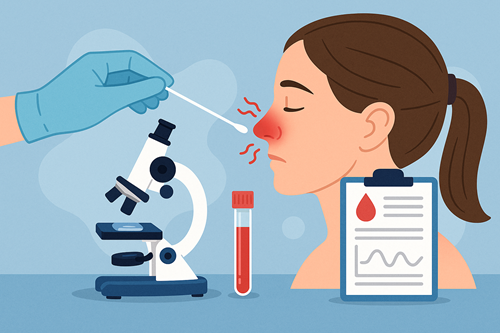Role of laboratory examinations in the diagnosis of vasomotor rhinitis: A Review of Literature
Abstract
Introduction: Vasomotor rhinitis (VMR) is a subtype of non-allergic rhinitis characterized by chronic nasal symptoms such as congestion, rhinorrhea, and sneezing without allergic or infectious causes. The absence of specific biomarkers makes VMR difficult to distinguish from allergic rhinitis, resulting in diagnostic challenges and potentially inappropriate therapy. This review aims to assess the contribution of laboratory examinations in the differential diagnosis of VMR.
Methods: A comprehensive literature search was performed using PubMed and Google Scholar databases for articles published between January 2021 and September 2025. Keywords included “non-allergic rhinitis,” “laboratory,” “IgE,” “eosinophil,” “nasal cytology,” “FeNO,” and “biomarker.” Out of 8,350 identified publications, 407 titles were relevant, and 57 full-text articles were reviewed. After applying inclusion and exclusion criteria, nine studies were selected for detailed analysis.
Results: No single laboratory test can confirm the diagnosis of VMR. Total and specific IgE levels, as well as peripheral eosinophil counts, mainly serve to exclude allergic rhinitis. Nasal cytology plays a crucial role in identifying subtypes of non-allergic rhinitis, including NARES and NARNE. Measurements of nasal nitric oxide (nNO/FeNO) and newer biomarkers, including diamine oxidase (DAO), show potential as supportive indicators, though findings remain inconsistent.
Conclusion: Laboratory examinations contribute primarily as adjunctive tools in differentiating VMR from allergic rhinitis. A multimodal diagnostic approach that integrates serological, cytological, and biomarker evaluations with clinical findings offers the most reliable strategy for improving diagnostic accuracy and guiding appropriate therapy.
Downloads
References
Admar, M. (2021) ‘The Association Between Allergic Rhinitis and Academic Achievement’, Jurnal Ilmiah Kesehatan Sandi Husada, 10(2 SE-Articles). doi: https://dx.doi.org/10.35816/jiskh.v10i2.652.
Baroody, F. M. et al. (2024) ‘Nonallergic Rhinopathy: A Comprehensive Review of Classification, Diagnosis, and Treatment’, The Journal of Allergy and Clinical Immunology: In Practice, 12(6), pp. 1436–1447. doi: https://doi.org/10.1016/j.jaip.2024.03.009.
Bocciolini, C. et al. (2023) ‘Middle meatus nasal cytology compared to inferior turbinate cytology in non allergic rhinitis’, European Archives of Oto-Rhino-Laryngology, 280(2), pp. 913–918. doi: https://dx.doi.org/10.1007/s00405-022-07629-8.
Britzius, S. et al. (2025) ‘Sympathetic arousals during sleep - observations in a cohort of healthy subjects’, Sleep Medicine, 134, p. 106689. doi: https://doi.org/10.1016/j.sleep.2025.106689.
Chaudhary, S. et al. (2024) ‘A comparative study of eosinophil count in nasal smear and peripheral blood smear in allergic and non-allergic rhinitis patients’, Indian Journal of Physiology and Allied Sciences, 76(02), pp. 31–34. doi: https://dx.doi.org/10.55184/ijpas.v76i02.205.
Chida, K. et al. (2025) ‘Rigorous multiple statistical test unveils combinations of preceding diseases at risk for the development of adult nephrotic syndrome’, Computers in Biology and Medicine, 192, p. 110360. doi: https://doi.org/10.1016/j.compbiomed.2025.110360.
Conner, J. E. and Steinberg, J. A. (2024) ‘Approach to Idiopathic Anaphylaxis in Adolescents’, Medical Clinics of North America, 108(1), pp. 123–155. doi: https://doi.org/10.1016/j.mcna.2023.05.018.
Czech, E. J., Overholser, A. and Schultz, P. (2024) ‘Allergic Rhinitis’, Medical Clinics of North America, 108(4), pp. 609–628. doi: https://doi.org/10.1016/j.mcna.2023.08.013.
Kalpaklioglu, A. F., Baccioglu, A. and Yalim, S. A. (2021) ‘Can nasal nitric oxide be a biomarker to differentiate allergic and non-allergic rhinitis?’, The Egyptian Journal of Otolaryngology, 37(1), p. 91. doi: https://dx.doi.org/10.1186/s43163-021-00154-1.
Liu-Lam, O. et al. (2025) ‘Rhinosinusitis’, Medical Clinics of North America. doi: https://doi.org/10.1016/j.mcna.2025.05.008.
Mahendran, K. et al. (2025) ‘Comparative Assessment Of Eosinophil Counts In Peripheral Blood And Nasal Smear In Non-Allergic And Allergic Rhinitis Subjects’, International Journal of Life Sciences, 14(7). doi: https://doi.org/10.69605/ijlbpr_14.7.2025.230.
Mantione, G. et al. (2025) ‘Clinical Findings, Feasibility, and Patient Tolerance of Nasopharyngeal Dx-pH System for Detecting Nasopharyngeal Reflux Disease’, Journal of Voice. doi: https://doi.org/10.1016/j.jvoice.2025.04.023.
Mayo-Yáñez, M. et al. (2023) ‘Diamine Oxidase Activity Deficit and Idiopathic Rhinitis: A New Subgroup of Non-Allergic Rhinitis?’, Life, 13(1), p. 240. doi: https://dx.doi.org/10.3390/life13010240.
Meng, Y., Wang, C. and Zhang, L. (2021) ‘Diagnosis and treatment of non-allergic rhinitis: focus on immunologic mechanisms’, Expert Review of Clinical Immunology, 17(1), pp. 51–62.
Okano, M. et al. (2025) ‘Practical guideline for the management of allergic rhinitis in Japan 2024’, Auris Nasus Larynx, 52(4), pp. 426–441. doi: https://doi.org/10.1016/j.anl.2025.05.005.
Papadopoulou, A. et al. (2023) ‘Nasal eosinophilia as a preliminary discriminative biomarker of non-allergic rhinitis in every day clinical pediatric practice’, European Archives of Oto-Rhino-Laryngology, 280(4), pp. 1775–1784. doi: https://dx.doi.org/10.1007/s00405-022-07704-0.
Rackerby, N. et al. (2025) ‘Evolving paradigms of treatment of allergic and nonallergic rhinitis’, Annals of Allergy, Asthma & Immunology, 135(1), pp. 15–22. doi: https://doi.org/10.1016/j.anai.2025.04.003.
Rizzi, A. et al. (2022) ‘Mometasone furoate in non-allergic rhinitis: a real-life Italian study’, Journal of Personalized Medicine, 12(7), p. 1179. doi: https://dx.doi.org/10.3390/jpm12071179.
Satia, I. et al. (2025) ‘The Clinical Approach to Chronic Cough’, The Journal of Allergy and Clinical Immunology: In Practice, 13(3), pp. 454–466. doi: https://doi.org/10.1016/j.jaip.2024.11.004.
Selçuk, A. and Keren, M. (2023) ‘The evaluation of eosinophil-to-lymphocyte, eosinophil-toneutrophil, and neutrophil-to-lymphocyte ratios in adults with allergic/non-allergic rhinitis’, Gulhane Medical Journal, 65(1), pp. 51–55. doi: https://dx.doi.org/10.4274/gulhane.galenos.2023.94840.
Solé, D. et al. (2025) ‘V Brazilian Consensus on Rhinitis – 2024’, Brazilian Journal of Otorhinolaryngology, 91(1), p. 101500. doi: https://doi.org/10.1016/j.bjorl.2024.101500.
Ünsal, H. and Ertürk, B. A. (2025) ‘Evaluation of children with allergic and non-allergic rhinitis and the effect of obesity/overweight in patients with allergic rhinitis’, Anatolian Current Medical Journal, 7(2), pp. 177–183. doi: https://dx.doi.org/10.1007/s00405-022-07629-8.
Wise, S. K. et al. (2024) ‘Rhinitis Disease Burden and the Impact of Social Determinants of Health’, The Journal of Allergy and Clinical Immunology: In Practice, 12(6), pp. 1449-1461.e1. doi: https://doi.org/10.1016/j.jaip.2024.03.043.
Xu, X. et al. (2024) ‘Blood and local eosinophil levels in chronic rhinitis: Observations during seasonal allergen exposure and non-exposure’, World Allergy Organization Journal, 17(7), p. 100930. doi: https://doi.org/10.1016/j.waojou.2024.100930.
Yang, W. et al. (2024) ‘Blocking CCL3-mediated neutrophil recruitment into the brain alleviates immunopathology following severe enterovirus 71 infection’, iScience, 27(12), p. 111388. doi: https://doi.org/10.1016/j.isci.2024.111388.

Copyright (c) 2025 Nur Wisma Arfiana, Nurul Sari Jayati, M Irvan Zufar, Kresna Aditya Nugraha Putra, Alya Fauzizah Hasmy

This work is licensed under a Creative Commons Attribution 4.0 International License.




2.png)
1.png)
1.png)










